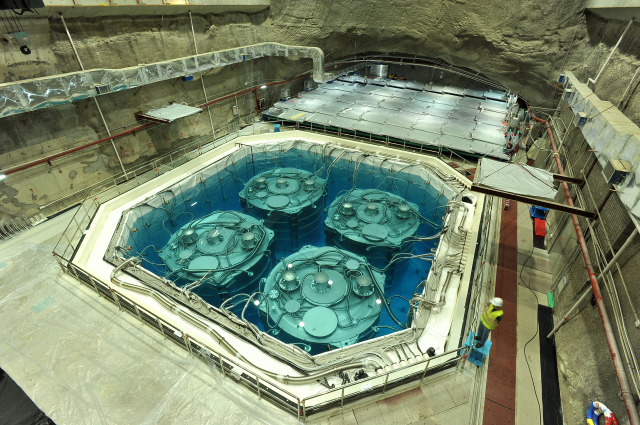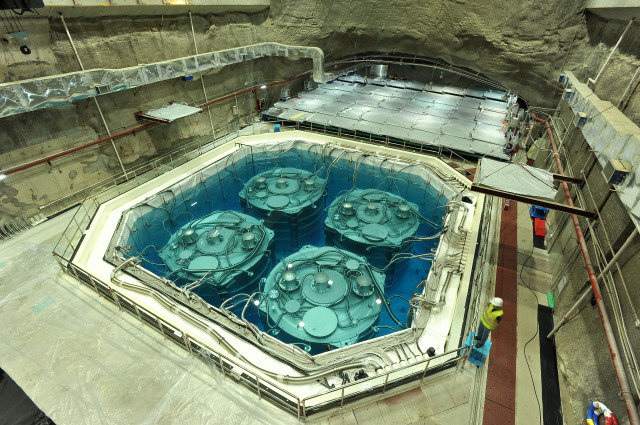By Wu Yuehui, People's Daily

Four neutrino detectors are installed in a huge pool. Photo by the Institute of High Energy Physics, Chinese Academy of Sciences
The Daya Bay Reactor Neutrino Experiment, a large-scale scientific facility of China, has successfully completed its mission and was decommissioned, announced Wang Yifang, academician of the Chinese Academy of Sciences (CAS) and director of the CAS Institute of High Energy Physics at the No. 3 experiment hall of the facility on Dec. 12.
The Daya Bay Reactor Neutrino Experiment has been operated 3,275 days since all its three experiment halls started running on Dec. 24, 2011.
Neutrinos account for 1/3 of the 12 kinds of fundamental particles that compose the material world. They exist broadly in the universe. As they don't react with almost all materials, it's not easy to capture them. That's why they are the least-understood fundamental particles so far.
"However, it's very important to study them, as it will help us reveal the mysteries of the universe's evolution," Wang said.
The Daya Bay Reactor Neutrino Experiment delivered outstanding performance in this regard over the past years.
Wang and his team announced a major breakthrough in March 2012. They for the first time discovered a third pattern of neutrino oscillations and accurately measured its oscillation probabilities. The finding triggered huge response in the international high-energy physics community, and was said to have opened a door for the future development of neutrino physics.
At the end of the same year, Wang and his team's finding was elected one of the top ten scientific breakthroughs of the year by the Science magazine. Later, Wang and his team also received numerous awards, including the Fundamental Physics Breakthrough Prize, hailed as the top prize in the science world.
The Daya Bay Reactor Neutrino Experiment completed a neutrino spectral analysis in 2013, which led to the first direct measurement of the mass-squared difference. Three years later, it completed the measurement of the reactor antineutrino flux and spectrum, which found two deviations from the theoretical model.
Besides, based on constant accumulation of data and the improvement made in technical analysis, the Daya Bay Reactor Neutrino Experiment continuously updated the results of mixed parameter measurement, maintaining the highest accuracy in the world.
"In foreseeable future, there will be no other experiment in the world that is able to surpass the Daya Bay Reactor Neutrino Experiment regarding measurement accuracy," Wang said.
As to why the fruitful experiment was halted, Wang explained that the previously set targets had all been completed, and to improve accuracy shall be a major goal if the facility was to keep operation. However, it would be meaningless as there's no way available to further lift the accuracy, he added.
The No. 1 experiment hall of the Daya Bay Reactor Neutrino Experiment will be turned into a scientific popularization venue after it's retired. "Though the tests are suspended, data analysis will keep running for two to three years, and further outcomes will be delivered," said researchers.
As the Daya Bay Reactor Neutrino Experiment announced its retirement, the Jiangmen Underground Neutrino Observatory, or JUNO, in south China’s Guangdong province, is under construction. The Daya Bay team is planning to build the world's largest liquid scintillator detector to keep capturing neutrinos. The detector is a 12-storey-high organic glass ball that contains 20,000 tonnes of liquid scintillator. It is by far the most complicated high-energy physics facility of China, and is expected to be finished in 2022.
"The facility is 20 times larger than the best facility of the same kind in today's world, and its definition is twice better," Wang said. Though both of the two experiments study neutrinos, they have completely different targets. The Daya Bay Reactor Neutrino Experiment aimed at measuring the third pattern of neutrino oscillations through the neutrinos generated in the reactors, while the JUNO is expected to determine neutrino mass hierarch and precisely measure oscillation parameters.
The mass of neutrinos is a fundamental parameter of the nature that impacts the evolution of the universe, and the hierarch will help determine the mass of neutrinos and pave a way for other studies, Wang said.
The Daya Bay Reactor Neutrino Experiment will be completely demolished six months later, and the JUNO will also stand ready soon. From Daya Bay to JUNO, Chinese high-energy physicists have always been challenging higher precisions. In their eyes, the higher the precision, the more they can find, and the more they know about the world.
The Daya Bay Reactor Neutrino Experiment has been operated 3,275 days since all its three experiment halls started running on Dec. 24, 2011.
Neutrinos account for 1/3 of the 12 kinds of fundamental particles that compose the material world. They exist broadly in the universe. As they don't react with almost all materials, it's not easy to capture them. That's why they are the least-understood fundamental particles so far.
"However, it's very important to study them, as it will help us reveal the mysteries of the universe's evolution," Wang said.
The Daya Bay Reactor Neutrino Experiment delivered outstanding performance in this regard over the past years.
Wang and his team announced a major breakthrough in March 2012. They for the first time discovered a third pattern of neutrino oscillations and accurately measured its oscillation probabilities. The finding triggered huge response in the international high-energy physics community, and was said to have opened a door for the future development of neutrino physics.
At the end of the same year, Wang and his team's finding was elected one of the top ten scientific breakthroughs of the year by the Science magazine. Later, Wang and his team also received numerous awards, including the Fundamental Physics Breakthrough Prize, hailed as the top prize in the science world.
The Daya Bay Reactor Neutrino Experiment completed a neutrino spectral analysis in 2013, which led to the first direct measurement of the mass-squared difference. Three years later, it completed the measurement of the reactor antineutrino flux and spectrum, which found two deviations from the theoretical model.
Besides, based on constant accumulation of data and the improvement made in technical analysis, the Daya Bay Reactor Neutrino Experiment continuously updated the results of mixed parameter measurement, maintaining the highest accuracy in the world.
"In foreseeable future, there will be no other experiment in the world that is able to surpass the Daya Bay Reactor Neutrino Experiment regarding measurement accuracy," Wang said.
As to why the fruitful experiment was halted, Wang explained that the previously set targets had all been completed, and to improve accuracy shall be a major goal if the facility was to keep operation. However, it would be meaningless as there's no way available to further lift the accuracy, he added.
The No. 1 experiment hall of the Daya Bay Reactor Neutrino Experiment will be turned into a scientific popularization venue after it's retired. "Though the tests are suspended, data analysis will keep running for two to three years, and further outcomes will be delivered," said researchers.
As the Daya Bay Reactor Neutrino Experiment announced its retirement, the Jiangmen Underground Neutrino Observatory, or JUNO, in south China’s Guangdong province, is under construction. The Daya Bay team is planning to build the world's largest liquid scintillator detector to keep capturing neutrinos. The detector is a 12-storey-high organic glass ball that contains 20,000 tonnes of liquid scintillator. It is by far the most complicated high-energy physics facility of China, and is expected to be finished in 2022.
"The facility is 20 times larger than the best facility of the same kind in today's world, and its definition is twice better," Wang said. Though both of the two experiments study neutrinos, they have completely different targets. The Daya Bay Reactor Neutrino Experiment aimed at measuring the third pattern of neutrino oscillations through the neutrinos generated in the reactors, while the JUNO is expected to determine neutrino mass hierarch and precisely measure oscillation parameters.
The mass of neutrinos is a fundamental parameter of the nature that impacts the evolution of the universe, and the hierarch will help determine the mass of neutrinos and pave a way for other studies, Wang said.
The Daya Bay Reactor Neutrino Experiment will be completely demolished six months later, and the JUNO will also stand ready soon. From Daya Bay to JUNO, Chinese high-energy physicists have always been challenging higher precisions. In their eyes, the higher the precision, the more they can find, and the more they know about the world.
 Menu
Menu
 China sets new targets for neutrino experiment
China sets new targets for neutrino experiment
















